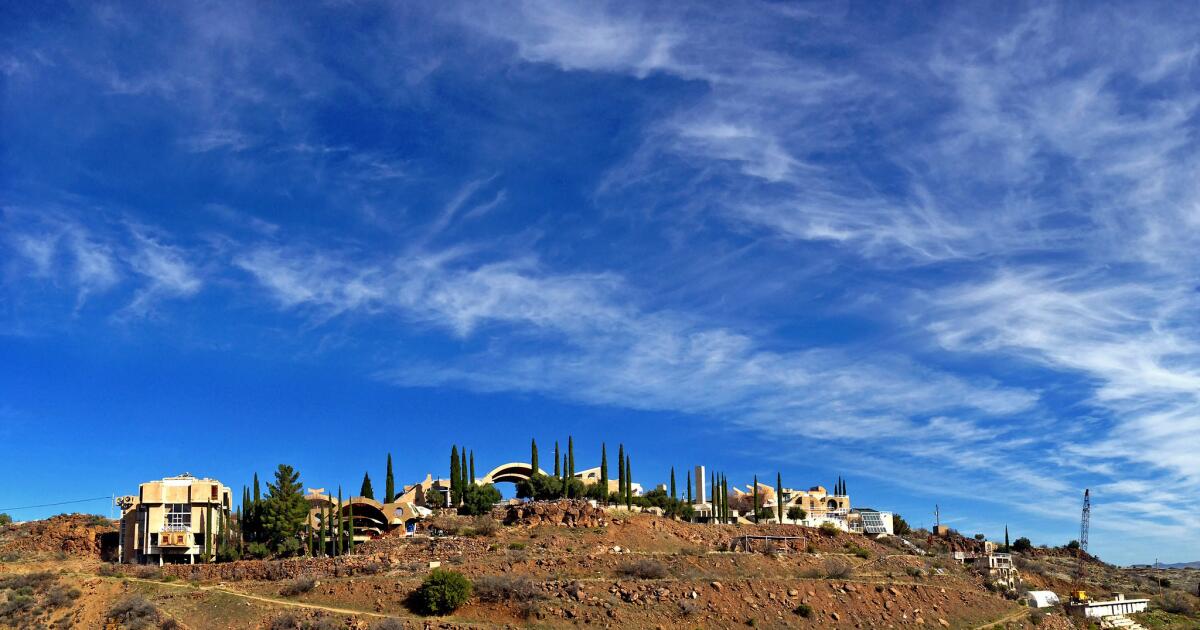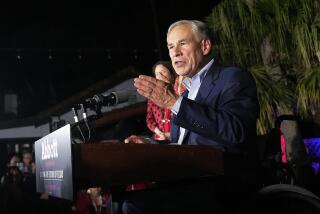Op-Ed: Are we greening our cities, or just greenwashing them?

The experimental town of Arcosanti, located in central Arizona, looks much the same today as it did shortly after most of its buildings were designed by architect Paolo Soleri and constructed in the 1970s.
- Share via
Architecture and urban design are in the throes of a green fever dream: Everywhere you look there are plans for “sustainable” buildings, futuristic eco-cities, even vertical aquaponic farms in the sky, each promising to redeem the ecologically sinful modern city and bring its inhabitants back into harmony with nature. This year, two marquee examples are set to open: Bjarke Ingels’ Via 57 West in New York, a 32-story luxury-apartment pyramid enfolding a garden, and the Louvre Abu Dhabi, by Jean Nouvel, a complex shielded from the harsh climate of the Arabian Peninsula by an enormous white dome. The dreamers’ goal is even bigger: “eco-cities” that will leapfrog the last century’s flawed development patterns and deliver us in stylish comfort to a low-carbon, green future.
In part, the dream reflects a pragmatic push for energy efficiency, recycled materials and lower carbon emissions — a competition rewarded with LEED certification in silver, gold or platinum. But it also includes a remarkable effort to turn buildings green — almost literally — by covering them in plants. Green roofs are sprouting on Wal-Marts and green walls festooned with ferns and succulents in Cubist patterns appear on hotels, banks, museums — even at the mall, as I found on a recent trip to the Glendale Galleria in Los Angeles.
Today’s green urban dream is too often about bringing a technologically controlled version of nature into the city and declaring the problem solved, rather than looking ... deeper.
All of this is surely a good idea, at some level: trying to repair some of the damage our lifestyle has done to the planet by integrating nature into what have been, especially in the modern era, wasteful, harsh, alienating, concrete urban deserts. But, despite the rhetoric of reconciling the city with nature, today’s green urban dream is too often about bringing a technologically controlled version of nature into the city and declaring the problem solved, rather than looking at the deeper causes of our current environmental and urban discontents.
Greening the city is not a new ideal. Ancient Romans waxed lyrical about Arcadia, a mythical bucolic escape from the ills of urban life: money-making, crime, pollution, disease and, of course, luxury and the moral turpitude that goes with it. City-dwellers have always been sensitive to the charge that the metropolis is guilty of a special kind of iniquity, which bars it from grace, and must be cleansed. (Remember Sodom and Gomorrah.) The corollary belief that the green countryside fosters all that is pure and wholesome is a foundational myth of Western culture. It is why, when most people amass enough filthy lucre, they move to the suburbs and cultivate a large, useless lawn, as if the greensward alone could buy them salvation.
Since Plato’s Republic, visionaries have described the ideal human community as something less like a city and more like a big, well-ordered farm. Think of Charles Fourier’s utopian phalanxes, the Shaker settlements, Frank Lloyd Wright’s proposed Broadacre City, Soviet collectives, Israeli kibbutzes or the innumerable 19th and 20th century “garden cities” strewn around the American and European landscapes. A more modest contemporary form is perhaps the Brooklyn Grange, the hipsterish but messianic urban farm outfit that grows bespoke salad greens hydroponically on several rented New York City rooftops for environmentally conscious urbanites. It is undoubtedly a beneficial enterprise, but, given the realities of high urban land values and labor costs, such a model is unlikely to replace the world’s nearly 6 million square miles of horizontal farms.
Today’s signature eco-building, Apple’s “spaceship” campus now under construction in Silicon Valley, designed by the British architect Norman Foster, is a good example of the shortcomings of the green dream. Though we are assured it will be sustainable, energy efficient and “slim” — preserving 80% of its 175-acre site for landscaping, it is by any measure a huge, complex, massively resource-intensive and incredibly expensive ($5 billion) folly, achievable only by one of the richest corporations on Earth. What is more damning is that, at the end of the day, it will be just another appendage of suburban sprawl, a white-collar workplace located next to a freeway, dependent on vast garages (even if most of them are tastefully buried) for its 13,000 commuters — and thus with no smaller environmental footprint than a conventional office park.
A look at the green dream’s origins is revealing. The Louvre Abu Dhabi, Apple’s spaceship and another new Silicon Valley “campus,” Google’s planned complex to be covered in transparent tenting that it says will “blur the difference between our buildings and nature,” are direct descendants of the work of the American visionary R. Buckminster Fuller and his Japanese partner, Shoji Sadao. In 1960, Fuller and Sadao proposed building a two-mile-wide, transparent geodesic dome over Midtown Manhattan. It would eliminate bad weather and the cost of heating and cooling separate buildings. It wasn’t built, but other, lesser domed environments were, all over the world, and these helped spawn a global epidemic of drawing-board futuristic eco-cities.
Among the movement’s avatars were Paolo Soleri, whose projected Utopia, Arcosanti, only amounted to a few, odd concrete structures in the Arizona desert, and the Japanese Metabolists of the 1960s and ‘70s, whose plans for massive floating city-farms and modular megastructures in the sky were outlandish. (They nevertheless directly influenced the development of undersea exploration modules, offshore oil platforms and the International Space Station.) Indeed, Foster was a student and later a collaborator of Fuller and Sadao, and his masterpieces — the Gherkin in London and the remade Reichstag in Berlin, to name just two of scores — are essentially climate-controlled domes, carefully modeled on his teachers’ earlier work.
Like driving a $85,000 Tesla, designing a perfect green building or eco-city isn’t enough to save the world.
These projects are, then, really the fulfillment of a set of blue-sky dreams from the Dr. Strangelove era — where every cinematic space colony contained a domed conservatory and keeping the plants in the greenhouse alive was all that stood between humans and disaster. In the end, those dreams are not about reintegrating society with nature, but leaving Earth itself behind for an
engineered habitat under the dome, in the sky or at least on the roof.
Like driving an $85,000 Tesla, designing a perfect green building or eco-city isn’t enough to save the world. Although our buildings, like our cars, have been woefully inefficient environmentally, architecture isn’t responsible in any meaningful way for humanity’s disastrous environmental impacts, nor can it hope to solve them alone. An economic system based on the destruction of nature and the shifting of real costs onto those less fortunate and onto the future, is the real problem. No dome can protect us from our own profligacy and improvidence, nor can any number of hydroponic lettuce farms blunt the damage being done to real nature, or what is left of it, on planet Earth.
Instead of making “nature” into an urban lifestyle accessory, architects and planners must work to design better relationships between the parts of our cities and nature, and to promote just relationships between the people in them. The work of this year’s Pritzker Prize winner, the Chilean architect Alejandro Aravena, is a case in point. He is less interested in making technologically impressive buildings than in collaborating with residents themselves to design low-cost, efficient housing solutions for the urban working class, especially in the wake of natural disasters. It is a more productive path forward than planting shrubs on skyscrapers.
Wade Graham’s latest book is “Dream Cities: Seven Urban Ideas That Shape the World.” He is a landscape designer as well as a historian and adjunct professor of public policy at Pepperdine Unversity.
Follow the Opinion section on Twitter @latimesopinion and Facebook
More to Read
A cure for the common opinion
Get thought-provoking perspectives with our weekly newsletter.
You may occasionally receive promotional content from the Los Angeles Times.









